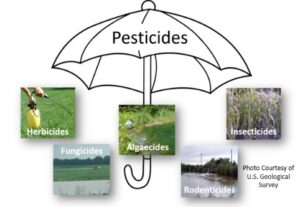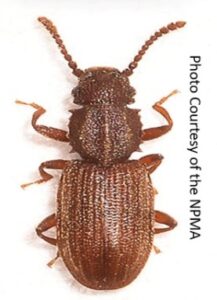Introduction to Systemic Pesticides
 The term pesticide is an “umbrella” term used to describe “a substance used for destroying insects or other organisms harmful to cultivated plants or to animals.” Pesticides have different formulations, modes of action and target organisms. Many pesticides used in agriculture and horticulture are considered systemic, meaning these pesticides (typically herbicides and insecticides) are absorbed by and transported through plants. The science behind systemic pesticides can render some or all of a plant toxic to insects that feed on plant tissue or toxic to the plant itself, eradicating the nuisance weed or plant.
The term pesticide is an “umbrella” term used to describe “a substance used for destroying insects or other organisms harmful to cultivated plants or to animals.” Pesticides have different formulations, modes of action and target organisms. Many pesticides used in agriculture and horticulture are considered systemic, meaning these pesticides (typically herbicides and insecticides) are absorbed by and transported through plants. The science behind systemic pesticides can render some or all of a plant toxic to insects that feed on plant tissue or toxic to the plant itself, eradicating the nuisance weed or plant.
Systemic insecticides are used against a wide variety of insects, mites, and nematodes. Many of the active ingredients are approved for use on hundreds of crops. Nursery and greenhouse plants, landscape plantings, trees, and turf, and non-crop sites (such as animal feeds and Christmas trees), are also commonly treated with systemic insecticides.
Some systemic insecticides are applied so that they are absorbed through the roots; from there they spread into above-ground plant tissues through the xylem vessels. Seed treatments, chemigation, soil granules, soil drenches, and soil injection are typical application methods for such xylem-mobile chemicals. Trunk injections can also send insecticides directly into the xylem, and are commonly used on orchard crops and woody plants produced in nurseries or grown for landscaping. Some systemics are also applied to trees through basal bark sprays. Xylem-mobile insecticides can be applied to plant foliage, but this method may result in less translocation, due partly to barriers to uptake through the leaves as well as to the removal of the insecticide from leaves by rain, dew, and mist. Phloem-mobile systemics are typically applied as foliar sprays; after absorption, they move through the phloem vessels, potentially reaching young leaves, roots, nectar and/or seeds (xerces.org).
Because systemic chemicals remain in the plant tissue, sometimes for lengthy periods of time, application methods often recommended to minimize contact to bees, such as spraying at night or applying outside of the flowering season, could still allow harmful exposures.
Systemic herbicides kill the entire plant by spreading gradually throughout its vascular system, from either foliar application down through the plant, or soil application, up towards the leaves. Systemic herbicides work after being absorbed by a plant’s leaves or roots and translocated to the rest of the plant (rigbytaylor.com).
Systemic herbicides are often used in “right of way” applications, Right of way applications are often used to remove vegetation that may impact road systems, create weed vectors, interfere with travel or breach utilities such as transmission lines and distribution lines for power or communication. Aerial or broadcast applications of systemic herbicides can be risky an may affect non-target vegetation which, in turn, could adversely affect wildlife, aquatic organisms, and pollinators.
In many states, right of way applications may require specialized training and licensing.
Submitted by: Rich Gibson, ACE, CFSQA
The Sawtooth Grain Beetle

Order:Coleoptera Family:Cucujidae Genus:Oryzaephilus Species:surinamensis
Sawtooth Grain Beetles (SGB) are one of the most important pests of stored products, which are commonly found in the home, retail (grocery stores) as well as warehousing & distribution. It’s a global pest of grain and grain products. The common name of this insect is derived from the 6 teeth located on each side of the prothorax. The prothorax is the first of three segments in the thorax of an insect and also contains the first pair of legs.
Adult SGB’s are approximately 1/8” (2.5 – 3 mm) long with a flattened body. Their coloring is brown and as previously mentioned, there are 6 sawlike teeth on each side of the prothorax. The wings are well developed but the insect cannot fly. The SGB and the Merchant Grain Beetle are very similar in appearance. One differentiating characteristic is the MGB can fly and are attracted to light. SGB’s go through complete metamorphosis (egg, larva, papal & adult). Mature larvae are yellowish white in color and less than 1/8” of an (3 mm) long. Antennae are 3 segmented with the 2nd segment the longest and the 3rd the smallest. The female can produce or lay 45 – 285 white, shiny eggs singularly or in small clusters within crevices in the food material during a 2 – 5 month period. The larvae crawl freely and feed on broken pieces of grain or grain kernels damaged by other insects. Larger larva may bore into the kernels. The majority of the damage done to grain is from the larvae. Adults and larvae are external feeders. On average, adults live 6 – 10 months but can live longer.
The SGB cannot attack sound kernels but it is known for considerable damage to grains. Food and food products, which are attacked by this insect include: bread, breakfast foods, candy bars, cereals, chocolate, dried meats, drugs, macaroni, pet foods & tobacco to name a few. Feeding results in shrinkage of the dry mass of the infested product and increased water content due to the metabolic activity of the insect. This can lead to the development of mold. Grain products, which have sustained damage have a decrease in value and are normally unfit for use.
The first step for control & elimination of the SGB is proper identification. Inspection of affected product(s) is next. Reviewing cleaning, receiving and storage practices independently as well as with the client is important. The location of where this insect can be found vary in size, which can make troubleshooting quite cumbersome. Upon finding an infestation or evidence of this insect, stored or incoming product should be immediately isolated. In the case where product(s) are being received by a vendor, infested product should be rejected. Ideally, damaged product should be destroyed. Proper storage practices utilizing FIFO (first in first out) should be practiced at all times. Ongoing cleaning is necessary and vacuuming of cracks & crevices should also be implemented. In some circumstances, freezing can be utilized which will eliminate all life cycle stages of the insect. Temperatures of 0 – 5° Fahrenheit must be held for at least 24 hours. Heat treatments of 125° Fahrenheit for one hour will also yield results. When using the two aforementioned methods, population levels will slowly begin to decrease over days & weeks. Fumigation, which is the treatment for controlling and eradicating a pest problem with the use of an approved gas material known as a fumigant can also be utilized by licensed applicator(s). The “Best Practice” is to follow standard control procedures for Stored Product Pests when dealing with the SGB.






